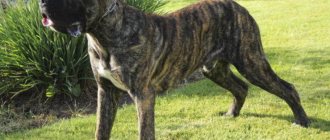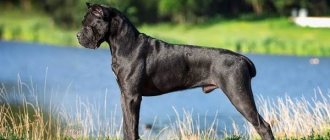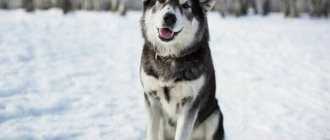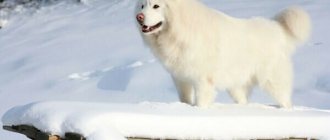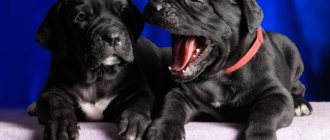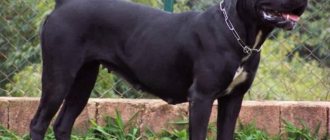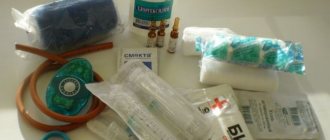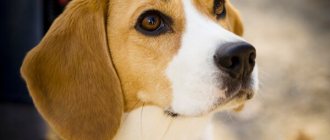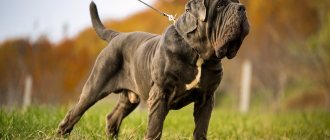History of the origin of the breed
Dogs of this breed have a fairly long history, although they were officially recognized only recently. Just like many other Great Dane breeds, Cane Corsos are considered descendants of the most ancient Asian dog breeds, which, in their important characteristics, are similar to Tibetan mastiffs.
Interesting information! Before the outbreak of World War II, dogs of this breed were very actively used to protect farms, were used in livestock protection processes, and were also indispensable for hunting.
Typically, due to their important characteristics, they took part in hunting large game. These dogs were especially popular in the Himalayas, as well as in the regions of Tibet. In addition, participating in the protection of various trade caravans, these dogs quickly became accustomed to various countries of the Euro-Asian continent.
Nutrition
The menu can be natural or the dog is fed premium food. Eating food is easier for the owner, because the dog does not need to prepare it separately. This is a time saver. Feeding natural food is no cheaper than feeding an expensive brand of food. The owner must choose the menu himself. It is important that the diet is balanced.
With a natural diet, it is not recommended to give the animal pork or smoked products. It is forbidden to serve spicy foods, and all types of river fish are not allowed on Cane Corso. You should not feed your dog high-fat dairy products. Millet and pearl barley are poorly absorbed and digested. Do not give your pet sweets, liquid soups, or garlic.
Description of the Cane Corso breed
This breed is considered legendary and deservedly so, but despite this, at one time they forgot about it, and it was on the verge of extinction. As always, there were real enthusiasts who managed to restore this breed to a level where it was no longer in danger of extinction. Selection work began when it was possible to find single specimens of purebred Cane Corso representatives.
Thanks to the process of active restoration of the breed, an association of Cane Corso lovers (Societa Amatori Cane Corso) was created. Modern males of this breed have a height at the withers of about 68 cm maximum, and females - about 64 cm. Moreover, their weight is: males weigh about 50 kg, and females - 45 kg.
Appearance
The appearance of the Cane Corso breed can be described quite briefly: a powerful and strong animal, at the same time very elegant. These are dogs that are distinguished by their above average body size, as well as the presence of lean and prominent muscles. Important characteristics of the breed include the size of the head, which is up to 36 percent of the size of the animal at the withers.
The owners of this breed value its high endurance and unique functionality most of all. At the same time, the dog does not have various excesses regarding its body shape, but has a unique performance capacity.
Coat type and color
The breed is distinguished by the presence of both guard hair and undercoat. Moreover, the undercoat must be clearly expressed, which applies to all purebred individuals.
Nowadays, the Cane Corso breed is classified as a guard dog, so it serves day and night and in any climatic conditions, protecting important territory and important objects. If a dog does not have an undercoat, it means it will not withstand sub-zero temperatures. One can say about the Cane Corso breed that it has a high-quality undercoat, so the dog is reliably protected from extreme conditions.
It is important to know! If a dog of this breed does not have an undercoat, then such individuals are classified as defective dogs, so they do not take part in further breeding. The fact that there is no undercoat indicates that the animal has nothing to do with purebred individuals.
The structure of the guard hair is represented by the core and cortex, in the form of granules with pigment. The outer part of the hair is covered with a special shell - the cuticle. The hairs of the undercoat are completely devoid of a core, and the cortical layer contains a small amount of pigment. In this regard, the undercoat has a lighter color. The variety of colors is associated with the presence of a special pigment, melanin, which is found in special cells called melanocytes.
The FCI-No. 343 breed standard specifies that Cane Corso dogs must have black, lead grey, slate grey, light grey, light fawn, red fawn, auburn and brindle coat colours. Representatives of the breed of red or brindle color must have a black or gray mask on the face, which should not extend beyond the general line of the eyes.
Minor inclusions of white are allowed, located in the chest area, on the back of the nose, and also on the tips of the paws.
Breed standards
The breed standards recorded in the FC documents are valid only from January last year. According to breed standards, these dogs must have:
- Large and typically mastiff-shaped head, with a slightly upturned muzzle.
- A wide skull with the presence of a frontal groove, a convex forehead in front, which has a noticeable flattening within the parietal region.
- Pronounced transition from forehead to muzzle.
- The nose is black and large, as well as wide and well-opened nostrils, which are in line with the nasal bridge.
- Square, massive muzzle, with a blunt but parallel lateral relief.
- Noticeably drooping upper lips that extend to the lower jaw.
- Quite large, massive and curved teeth with a dense overbite.
- Medium-sized, oval, straight-set, slightly convex eyes with close-fitting eyelids. At the same time, the iris of the eyes has a dark tint, and the eyes themselves are distinguished by a penetrating and quite attentive gaze.
- Triangular, drooping ears with a wide base and set high above the cheekbones.
- Strong, muscular neck, the length of which is equal to the length of the head.
- Pronounced withers that rise above the croup.
- Well developed chest reaching to the elbows.
- The tail is set high and very thick at the base, which the animal holds high when moving.
The animal's forelimbs are quite long, with oblique and very muscular shoulders. The humerus is strong and the forearms are almost vertical and strong. The wrists are flexible and the paws are cat-like. The hind limbs end in long and wide hips. The back line is convex, and the lower legs are strong and fleshy. The movements are quite wide and sweeping.
Cane Corso - All about the breed
Behavioral nature of the Cane Corso
Dogs of this breed, like other representatives of Molossians, have a fairly strong character. At the same time, individuals tend to show independence, along with signs of stubbornness. Despite this, Cane Corsos rarely show signs of dominance in relation to their owner, although in some other similar breeds these indicators are clearly expressed and without proper and targeted training, individuals are enviably stubborn.
As a result of long-term observations, it was found that the character of this breed is quite docile and, with reasonable, professional training, the dogs are obedient and easy to control. If you keep an animal in the family from an early age, raising the dog competently, then it will grow up to be an affectionate and sociable friend of the whole family. The Cane Corso will always appreciate the time spent on him and will repay him with a patient attitude towards the youngest members of the family.
Interesting to know! These dogs are considered reliable and intelligent watchdogs who will never bark at passers-by, only lending their voice when necessary or at the request of the owner.
This is a strong, athletic animal that will always take part in outdoor games or simply run around, since it is characterized as mobile and active, which is associated with an incredibly high level of temperament. The significant advantages of the Cane Corso include the dog’s devotion to all family members and affection for its owner. At the same time, the dog has watchdog and security qualities that have not yet been lost.
How long do they live?
Dogs of this breed are not considered long-lived, so their average life expectancy is 12 and a half years. At the same time, even with advanced age, Cane Corsos always remain cheerful, playful and cheerful, continuing to lead an active lifestyle until their last days.
Color options when mating with different coat colors
Let's now take a closer look at what color options are possible when breeding dogs with different coat colors.
Absolutely black parents can produce not only black puppies, but also blue (a shade of gray), brindle, blue-brindle with a blue mask, red with a black mask and fawn with a blue mask.
Also, black parents may have a gray baby with black eyelids, lips and a gray nose. The black color is not caused by any one gene, but by the combination Ay-BD-Em-K-. You can see for yourself how much space Mother Nature has for creativity.
If you breed brindles, they will also give a variety of offspring, but there will be no black babies.
At the same time, if one of the parents has a solid color, but has at least one tiny “tiger”, he can no longer pass on the gene necessary for the formation of black color. In brindle dogs, the puppies will be brindle with a black mask, red with a black mask, blue brindle with a blue mask, or fawn with a blue mask.
If blue brindle and blue dogs are bred, then all the offspring will be light colors: the same colors as the mother and father, or light red with a blue mask, formentino.
Parents who are red with black or blue masks will produce red puppies with a black mask or fawn with a blue mask.
If you study the genetics of colors in detail, you can control the color of the coat of future babies.
Keeping a Cane Corso at home
This popular Italian breed does not require special housing conditions, and it will feel great both in a city apartment and on the street, in a specially equipped cage. Despite the ease of care, you still have to adhere to a number of recommendations for care and hygiene. It is very important to provide the animal with nutritious food.
Care and hygiene
Despite the fact that the Cane Corso breed is short-haired, it is still necessary to take care of the coat. The dog needs regular massage, as well as combing out dead hair. This will preserve the dog’s natural shine and beauty of its coat. To clean the fur, you can use a special medium-hard brush. It is necessary to comb the fur in the direction of its growth.
Ear hygiene comes down to standard actions to remove dirt or natural secretions, in the form of earwax. As a rule, the ears are cleaned with small cotton-gauze swabs. They are soaked in heated vegetable oil or in a special solution of chamomile with hydrogen peroxide.
It is important to know! Caring for a dog's oral cavity requires special measures, since tartar may form. To prevent this from happening, it is necessary to clean the dog’s mouth with pastes and brushes specially designed for this purpose.
If discharge in the form of purulent formations accumulates in the eyes of an animal, then this should not be classified as a pathology. These secretions should be carefully removed using a gauze cloth, which should preferably be moistened in a special solution of medicinal chamomile. If tartar does appear on the teeth, it can only be removed with the help of a professional.
What to feed your Cane Corso
Already from 3 weeks of age, the dog should be accustomed to a classic diet. Naturally, the puppy is fed according to a schedule, several times a day, dividing the diet into equal parts. Dishes for food and water should be at the same level as the chest on special stands. Natural food should include the following nutritional components:
- Lean meat.
- Sea fish.
- Boiled eggs.
- Low-fat milk.
Up to 2 and a half months of age, meat should be given, minced by scraping. For this age, lean beef, rabbit or chicken are suitable. Upon reaching 6 months of age, the animal’s diet should be expanded to include offal, as well as raw beef bones, including sea fish and dairy products. Buckwheat, oatmeal or rice porridge is prepared with milk. Foods such as cabbage, carrots and beets are high in vitamins and minerals. These include some berries and fruits.
Dry commercial food is also suitable for providing your pet with adequate nutrition. For an adult dog, the daily ration is calculated based on the requirement of about 20-40 grams per 1 kg of the animal’s body weight. It turns out about 1 kg of dry food per day.
Diseases and breed defects
This breed of dog may suffer from eversion or entropion of the eyelids, excessive tearing, and cherry eye. In this case, there is also bloating and epilepsy, problems with the normal functioning of the thyroid gland, as well as the manifestation of allergic reactions.
There may also be deviations in the parallelism of the muzzle and forehead, as well as anomalies in the shape of the muzzle, which may be expressed in an overly upturned or wedge-shaped shape. There is also partial depigmentation of the nose, a clear undershot or scissor bite, a hooked tail, against the background of deviations in growth standards.
The main disqualifying defects include a drooping muzzle, lack of pigmentation of the nose, hooked nose and underbite, lack of pigmentation of the eyelids, blue eyes, squint, including a stubby tail. The quality of the wool should not go beyond the requirements, so the wool should be short, not smooth and not have obvious fringes.
Education and training
The process of raising a Cane Corso should boil down to teaching the animal to follow the commands of its owner, regardless of the circumstances. Considering the fact that the breed is quite intelligent, harsh training methods should under no circumstances be used.
Important to remember! If you raise a dog of this breed correctly and professionally, then it will never bring problems to the owner, including his family members. In this case, emphasis should be placed on game-based learning methods, showing a certain persistence in executing the required commands. Excessive rudeness can lead to unmotivated stubbornness.
At the initial stages of training, the puppy must master basic commands, such as “Near”, “Sit”, “Lie down”, “No”, etc. At this stage, the puppy should get used to the leash and the basic requirements of discipline.
162. Training a Cane Corso puppy. First training
Learning ability
The Cane Corso is a stubborn and cunning dog. During training, she tries with all her might to ignore her owner’s commands, especially in puppyhood.
A beginner needs to make an appointment with a professional dog handler - it is impossible to achieve obedience on your own without experience.
If you show persistence and methodically repeat commands on every walk and ensure their implementation, training a Cane Corso will not be difficult - it will master the general training course and protective service.
Start raising a puppy by establishing clear rules of behavior in the apartment. If the puppy does unwanted actions - climbs on the bed or chews slippers - scold him. Encourage positive moments. A smart Corso will quickly understand what they want from him.
Cane Corso breed: where to buy
Nowadays, purchasing a purebred puppy of this breed is very problematic. In addition, choosing a puppy is a problem that can only be handled by a professional. Under no circumstances should you rely on your basic knowledge or simply on the recommendations of breeders.
It is very good if kennels that practice breeding dogs of a famous breed use imported producers related to the ancestors of real Cane Corsos. This will be proof that they sell dogs with typical behavior, high performance, strong bones and graceful movements. Parents of puppies must pass all tests and be verified by producers who are not prone to dysplasia.
What to pay attention to
When choosing a Cane Corso puppy, you should pay special attention to such factors as:
- The parents of the puppy have all the documents indicating that they have passed all tests for the presence of elbow and hip dysplasia, with an official conclusion from an RKF specialist.
- The parents have all tests related to the absence of mental defects, which must be certified in a separate document.
- A parent pair participating in breeding work must have a “very good” rating obtained at a breeding show.
As a rule, babies from multiple litters are larger in size, and they are stronger and more well-fed. Despite this, puppies must be absolutely healthy, active and playful, have an excellent appetite, show curiosity and not be cowardly. Nowadays, it is more common to sell animals that solely in appearance resemble breed standards.
These pets may develop various negative behavioral problems over time. This could be either a defect in the work of the breeders, or problems with raising the animal, which is more likely, since not all owners bother themselves with the problems of raising and socializing the animal.
All puppies offered must have all vaccinations and ears and tail docked. Babies can easily be determined whether they correspond to the breed type by their good anatomical structure, as well as by their clean and calm look. Such individuals are practically socialized and have a stable and strong psyche. All that remains is to properly raise the animal in the family, in a calm environment. Accompanying documents must indicate that the puppies have all vaccinations. The owner must have documents such as birth certificates, veterinary passports and a standard purchase and sale document in his hands.
Cost of Cane Corso puppies
It is quite natural that puppies whose pedigree includes producers of the most famous world-famous kennels, such as “Della Porta Dipinta”, “Del Rosso Malpelo”, “Cane Per La Vista” and “Best Griffs Off Destiem”, are the most expensive. The most expensive puppies, and therefore the most promising, quite often become titled, both abroad and in our country.
As a rule, the cost of a purebred puppy starts from 1 thousand dollars and no lower. At the same time, individuals with rare coat colors are much more expensive.
How to choose?
Before choosing a Cane Corso puppy, you need to choose a kennel. It is important that the nursery maintains the purity of the breed and its quality.
It is necessary to pay attention to:
- cost of a puppy – quality Blue Corso puppies cost from $250 to $1,500;
- nursery conditions;
- availability of documents for puppies;
- presence of pedigree;
- the behavior of the breeder himself.
The puppy must be strong, well-fed, active and courageous . It is best to ask the breeder to show the puppy's father and mother, then the breed standard can be assessed.
IMPORTANT!
The puppy must have a puppy certificate and an international veterinary passport, which contains information about vaccinations and helminth prevention.
Such a document is issued 45 days after the birth of the puppies.
There must be a mark on the dog’s belly that corresponds to what is indicated in the metric.
Owner reviews
Naturally, not everyone welcomes the fact of keeping dogs of similar breeds at home. This dog is not small, so it needs enough living space. What if there are two dogs? According to experienced dog breeders, it is permissible to keep 2 dogs of the same breed in the house, but you need to know that 2 bitches get along quite easily and without problems in the same territory. If we talk about male dogs, they do not get along well and often conflict with each other. One can only imagine how dangerous these conflicts are, given their origins.
The Cane Corso breed is distinguished by the fact that physical activity, in the form of frequent and long walks, is very important for normal life. Despite the characteristics of the breed, even novice dog breeders can have it. In this case, it is better to visit training grounds and contact professionals.
Note to everyone! Those who want to have a Cane Corso dog at home should know that external characteristics, mental characteristics and behavioral characteristics, as well as working characteristics, are inherited by the animal. Therefore, the best option is to purchase a puppy from a specialized nursery.
This approach allows us to minimize the risks associated with purchasing an animal that does not meet breed standards. If you choose a puppy wisely, and then also raise it wisely, you can get a faithful and affectionate friend for life. It is better to purchase a puppy after reaching 6 months of life, since by this period the teeth change, so you can determine the nature of the bite, including the color of the eyes. By this point, it is already possible to easily determine deficiencies in the structure of the limbs, as well as the nature of movement.
Life expectancy and health
Life expectancy is approximately 10-11 years .
The Corso is in good health, but problems can still arise. The dog is prone to bloating, which in most cases is associated with poor nutrition. In addition, allergic reactions occur, especially when new foods are introduced into the diet.
CAREFULLY!
As for more serious ailments, the Corso may have ectropion of the eyelid, hyperthyroidism, and epilepsy.
In order to detect the disease in time, it is necessary to carefully monitor the dog’s behavior, as well as undergo regular preventive examinations with a veterinarian.
If your dog has indigestion, whines and walks poorly, you should not wait for a routine examination, you must immediately contact the clinic.
Varieties
The purebred Italian Cane Corso Mastiff is a muscular and smooth-haired representative of the breed. There are other varieties that are similar in appearance and belong to the Molosser section, the Mastiff subsection. The “relatives” of the Cane Corso and their distinctive features are described in the table.
Table - Representatives of mastiffs close to the Cane Corso
| View | Peculiarities |
| Mastino or Neapolitan Mastiff | — Powerful elongated body; - long graceful legs; - massive head; - muzzle with numerous voluminous folds |
| Bullmastiff | — Large body; - massive round head with a dark mask; - folds on the muzzle |
| German dog | - Narrow chest; - graceful legs; - elongated dark muzzle; - Long neck |
| English Mastiff | — Powerful body (the largest representative of mastiffs); - massive dark head |
| German boxer | — Average body size; - small round head; - characteristic “snub-nosed” muzzle |
Despite the similarity and kinship, each representative of the mastiff differs in temperament, tolerance towards children, and intelligence. Therefore, before “replacing” the Cane Corso with another representative of the breed, you should study the characteristics of behavior, training, and care.
Top nicknames
A pleasant and at the same time difficult moment when getting a dog is choosing a suitable name. The nickname should suit the breed well, emphasize the characteristics of the pet, and at the same time be sonorous and beautiful to the ear.
The Cane Corso is a majestic and noble dog with the habits of an aristocrat, so the name should match. Keeping in mind the origin of the breed, you can choose sonorous Italian names. The table below gives examples of nicknames for your favorite male or female dog.
Table - Pet name options
| Nicknames for Cane Corso “boy” | Nicknames for Cane Corso “girls” |
| — Argon; — Andrea; — Bonya; — Vinci; — Hector; — Django; - Prince; — Leonard; - Mauro — Pepito | - Aina; - Beatrice; — Betty; - Valencia; — Gabrielle; - Ghersi; — Irma; — Loya; — Naomi; - Erika |
In order for the animal to quickly get used to its name, it is worth naming the pet exclusively in a positive way. When punishing, it is better to avoid calling him by name, otherwise his own nickname will cause stress and guilt in the dog.
THE JAPANESE SPITCH IS A FRIENDLY AND CHEERFUL TOY DOG WITH A PLEASANT CHARACTER, BRIGHT APPEARANCE AND EXTRAORDINARY INTELLIGENCE
JAPANESE CHIN – BREED DESCRIPTION
SOUTH RUSSIAN SHEPHERD – AN UNDEservEDLY FORGOTTEN PEARL OF DOMESTIC DOG BREEDING
THE AIREDALE TERRIER IS A STRONG AND MUSCULAR MEDIUM-SIZED DOG WITH A CENTENNIAL LEGENDARY PAST
Appearance
In accordance with the general appearance of the breed, Cane-Corso dogs have an above average build, strong and strong, quite elegant, with lean and powerful muscles. Important ratios include the length of the head, which is about 36% of the height of the animal at the withers.
The format of an adult dog is somewhat stretched . Fans of the Corso breed most of all value endurance and incredible functionality in such dogs, as well as the complete absence of any excess in form and enormous performance.
Attitude towards children
The Cane Corso treats children with care, with a share of “parental” attention. He will never offend the weak and will tolerate even inaccurate advances from strangers. If the Corso gets tired of children's attention, he will try to leave, and if he cannot, he will courageously endure manifestations of love.
Unlike other large dogs, the cane is well aware of its size and behaves carefully with children. It will not crush even the smallest ones with its own weight. The worst punishment for a sensitive cane is the childish tears of a child under his care.
